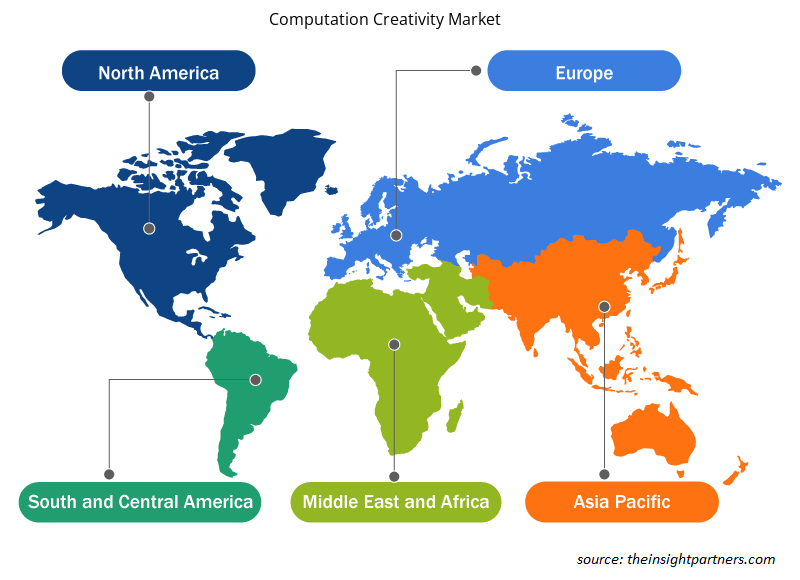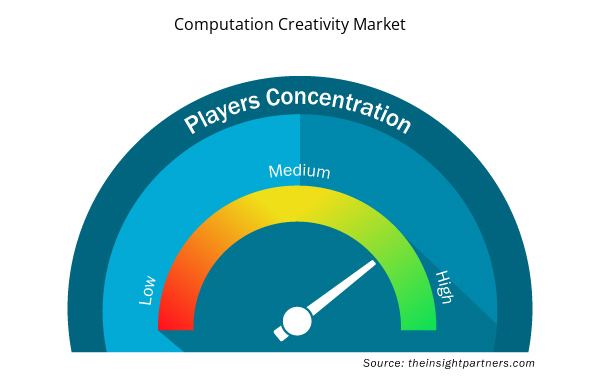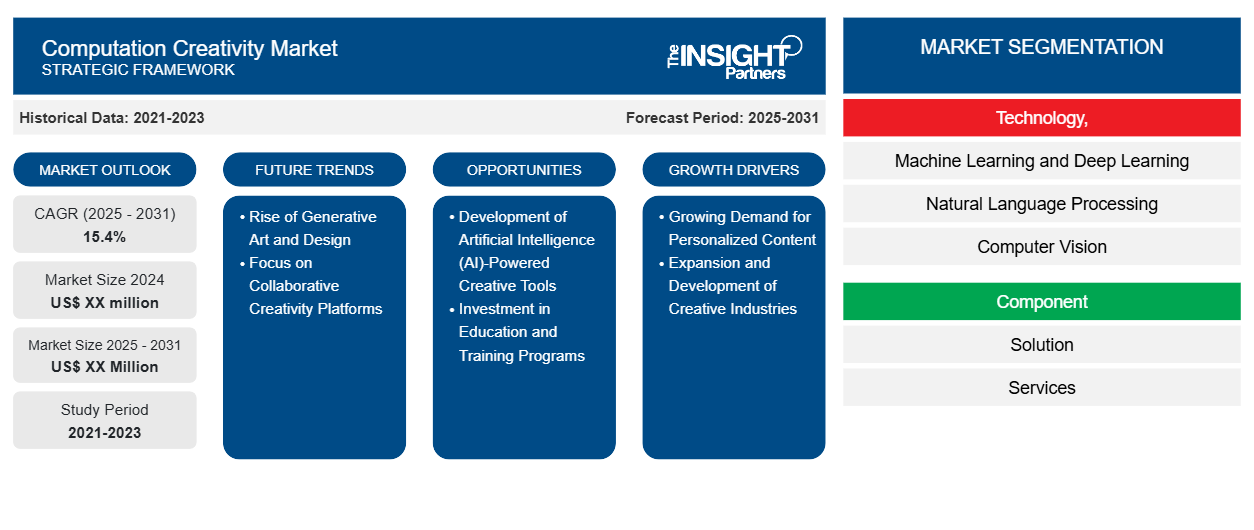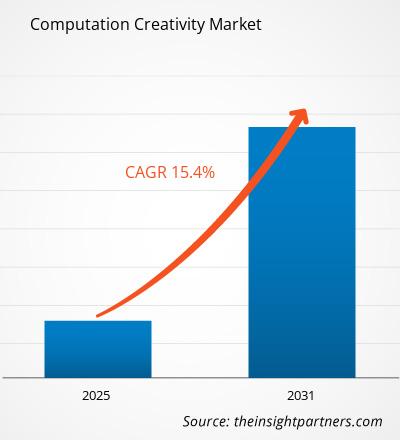Se espera que el mercado de creatividad computacional registre una CAGR del 15,4 % entre 2023 y 2031, con un tamaño de mercado que se expandirá de US$ XX millones en 2023 a US$ XX millones en 2031.
El informe está segmentado por tecnología (aprendizaje automático y aprendizaje profundo, procesamiento del lenguaje natural, visión artificial); componente (solución, servicios); aplicación (marketing y diseño web, diseño de productos, composición musical, fotografía y videografía, desarrollo de videojuegos de alta gama, generación automatizada de historias). El análisis global se desglosa aún más a nivel regional y por países principales. El informe ofrece el valor en USD para el análisis y los segmentos anteriores.
Propósito del Informe
El informe Computation Creativity Market de The Insight Partners tiene como objetivo describir el panorama actual y el crecimiento futuro, los principales factores impulsores, los desafíos y las oportunidades. Esto proporcionará información a diversas partes interesadas del negocio, como:
- Proveedores/fabricantes de tecnología: Para comprender la dinámica cambiante del mercado y conocer las oportunidades potenciales de crecimiento, lo que les permitirá tomar decisiones estratégicas informadas.
- Inversionistas: Realizar un análisis exhaustivo de tendencias sobre la tasa de crecimiento del mercado, las proyecciones financieras del mercado y las oportunidades que existen en toda la cadena de valor.
- Órganos reguladores: Regular las políticas y vigilar las actividades del mercado con el objetivo de minimizar los abusos, preservar la confianza de los inversores y defender la integridad y la estabilidad del mercado.
Segmentación del mercado de creatividad computacional
Tecnología,
- Aprendizaje automático y aprendizaje profundo
- Procesamiento del lenguaje natural
- Visión por computadora
Componente
- Solución
- Servicios
Solicitud
- Marketing y diseño web
- Diseño de productos
- Composición musical
- Fotografía y videografía
- Desarrollo de videojuegos de alta gama
- Generación automática de historias
Geografía
- América del norte
- Europa
- Asia-Pacífico
- América del Sur y Central
- Oriente Medio y África
Geografía
- América del norte
- Europa
- Asia-Pacífico
- América del Sur y Central
- Oriente Medio y África
Personalice este informe según sus necesidades
Obtendrá personalización en cualquier informe, sin cargo, incluidas partes de este informe o análisis a nivel de país, paquete de datos de Excel, así como también grandes ofertas y descuentos para empresas emergentes y universidades.
- Obtenga las principales tendencias clave del mercado de este informe.Esta muestra GRATUITA incluirá análisis de datos, desde tendencias del mercado hasta estimaciones y pronósticos.
Factores impulsores del crecimiento del mercado de la creatividad computacional
- Demanda creciente de contenido personalizado: En una era de sobrecarga de información, existe una demanda creciente de contenido personalizado que satisfaga las preferencias y necesidades individuales. Las herramientas de creatividad computacional aprovechan el análisis de datos para crear experiencias personalizadas, mejorando la participación del cliente en varios sectores, incluidos el marketing, el entretenimiento y la educación. A medida que las marcas se esfuerzan por conectar con su audiencia a un nivel más profundo, la capacidad de generar contenido único y personalizado utilizando métodos computacionales se convierte en una ventaja competitiva vital que impulsa el crecimiento del mercado.
- Expansión y desarrollo de las industrias creativas: la expansión de las industrias creativas, incluidos los videojuegos, el cine y los medios digitales, desempeña un papel fundamental en el impulso del mercado de la creatividad computacional. A medida que estos sectores continúan evolucionando e innovando, existe una creciente necesidad de herramientas avanzadas que puedan agilizar el proceso creativo, mejorar la productividad y facilitar la colaboración entre los equipos creativos. Esta demanda de soluciones sofisticadas que integren la creatividad computacional en el proceso de producción está impulsando el crecimiento del mercado y abriendo nuevas vías para los avances tecnológicos.
Tendencias futuras del mercado de la creatividad informática
- El auge del arte y el diseño generativos: el auge del arte y el diseño generativos está transformando el panorama del mercado de la creatividad computacional. Los artistas y diseñadores están experimentando con algoritmos y técnicas computacionales para producir obras de arte únicas y visualmente impactantes. Esta tendencia no solo está democratizando la creación artística, sino que también fomenta la colaboración entre artistas y tecnólogos. A medida que el arte generativo gana popularidad, surgen plataformas y herramientas que respaldan este movimiento, impulsando la innovación y expandiendo los horizontes de la expresión creativa.
- Enfoque en plataformas de creatividad colaborativa: cada vez se presta más atención a las plataformas de creatividad colaborativa que permiten a los equipos trabajar juntos sin problemas, independientemente de la ubicación geográfica. Estas plataformas utilizan tecnologías basadas en la nube e inteligencia artificial para facilitar la colaboración en tiempo real, lo que permite que varios usuarios contribuyan a proyectos creativos simultáneamente. A medida que el trabajo remoto se vuelve más frecuente, la demanda de dichas plataformas aumenta, lo que fomenta una nueva era de colaboración creativa e innovación que mejora el proceso creativo general.
Oportunidades de mercado en la creatividad computacional
- Desarrollo de herramientas creativas basadas en inteligencia artificial (IA): los avances continuos en IA presentan una oportunidad significativa para el desarrollo de herramientas creativas basadas en IA adaptadas a diversas industrias. Las empresas pueden invertir en la creación de software especializado que aproveche las capacidades de la IA para ayudar a los profesionales a generar contenido, mejorar el diseño o automatizar tareas repetitivas. Al ofrecer soluciones innovadoras que agilicen los procesos creativos, las empresas pueden captar participación de mercado y satisfacer las necesidades cambiantes de los creadores, educadores y vendedores en un panorama que cambia rápidamente.
- Inversión en programas de formación y capacitación: con la creciente adopción de herramientas de creatividad computacional, existe una creciente necesidad de programas de formación y capacitación que proporcionen a las personas las habilidades necesarias para aprovechar estas tecnologías de manera eficaz. Esto presenta una oportunidad para que las instituciones educativas y las empresas desarrollen planes de estudio y módulos de capacitación centrados en la creatividad computacional, la inteligencia artificial y el pensamiento de diseño. Al invertir en iniciativas educativas, las organizaciones pueden crear una fuerza laboral capacitada capaz de aprovechar herramientas y tecnologías avanzadas, lo que en última instancia impulsa la innovación y el crecimiento en el campo.
Perspectivas regionales del mercado de creatividad computacional
Los analistas de Insight Partners explicaron en detalle las tendencias y los factores regionales que influyen en el mercado de creatividad computacional durante el período de pronóstico. Esta sección también analiza los segmentos y la geografía del mercado de creatividad computacional en América del Norte, Europa, Asia Pacífico, Medio Oriente y África, y América del Sur y Central.

- Obtenga datos regionales específicos para el mercado de creatividad computacional
Alcance del informe sobre el mercado de la creatividad computacional
| Atributo del informe | Detalles |
|---|---|
| Tamaño del mercado en 2023 | XX millones de dólares estadounidenses |
| Tamaño del mercado en 2031 | US$ XX millones |
| CAGR global (2023 - 2031) | 15,4% |
| Datos históricos | 2021-2022 |
| Período de pronóstico | 2024-2031 |
| Segmentos cubiertos | Por tecnología,
|
| Regiones y países cubiertos | América del norte
|
| Líderes del mercado y perfiles de empresas clave |
|
Densidad de actores del mercado de creatividad computacional: comprensión de su impacto en la dinámica empresarial
El mercado de la creatividad computacional está creciendo rápidamente, impulsado por la creciente demanda de los usuarios finales debido a factores como la evolución de las preferencias de los consumidores, los avances tecnológicos y una mayor conciencia de los beneficios del producto. A medida que aumenta la demanda, las empresas amplían sus ofertas, innovan para satisfacer las necesidades de los consumidores y aprovechan las tendencias emergentes, lo que impulsa aún más el crecimiento del mercado.
La densidad de actores del mercado se refiere a la distribución de las empresas o firmas que operan dentro de un mercado o industria en particular. Indica cuántos competidores (actores del mercado) están presentes en un espacio de mercado determinado en relación con su tamaño o valor total de mercado.
Las principales empresas que operan en el mercado de la creatividad computacional son:
- IBM
- Microsoft
- Adobe
- Servicio web de Amazon, Inc.
Descargo de responsabilidad : Las empresas enumeradas anteriormente no están clasificadas en ningún orden particular.

- Obtenga una descripción general de los principales actores clave del mercado de creatividad computacional
Puntos de venta clave
- Cobertura integral: el informe cubre de manera integral el análisis de productos, servicios, tipos y usuarios finales del mercado de creatividad computacional, proporcionando un panorama holístico.
- Análisis de expertos: el informe se compila sobre la base de un profundo conocimiento de expertos y analistas de la industria.
- Información actualizada: El informe asegura relevancia comercial debido a su cobertura de información reciente y tendencias de datos.
- Opciones de personalización: este informe se puede personalizar para satisfacer los requisitos específicos del cliente y adaptarse adecuadamente a las estrategias comerciales.
Por lo tanto, el informe de investigación sobre el mercado de la creatividad computacional puede ayudar a abrir camino para descifrar y comprender el escenario de la industria y las perspectivas de crecimiento. Si bien puede haber algunas preocupaciones válidas, los beneficios generales de este informe tienden a superar las desventajas.
- Análisis histórico (2 años), año base, pronóstico (7 años) con CAGR
- Análisis PEST y FODA
- Tamaño del mercado Valor/volumen: global, regional, nacional
- Industria y panorama competitivo
- Conjunto de datos de Excel


- Hummus Market
- Explosion-Proof Equipment Market
- Wheat Protein Market
- Artificial Intelligence in Healthcare Diagnosis Market
- Artificial Intelligence in Defense Market
- Collagen Peptides Market
- Virtual Pipeline Systems Market
- Aerospace Forging Market
- Water Pipeline Leak Detection System Market
- Gas Engine Market

Report Coverage
Revenue forecast, Company Analysis, Industry landscape, Growth factors, and Trends

Segment Covered
This text is related
to segments covered.

Regional Scope
North America, Europe, Asia Pacific, Middle East & Africa, South & Central America

Country Scope
This text is related
to country scope.
Preguntas frecuentes
Some of the customization options available based on the request are an additional 3-5 company profiles and country-specific analysis of 3-5 countries of your choice. Customizations are to be requested/discussed before making final order confirmation# as our team would review the same and check the feasibility
The report can be delivered in PDF/PPT format; we can also share excel dataset based on the request
The major factors driving the Computation Creativity market are Rise in Digital Transformation and Automation and Growing Demand for Content Personalization and Localization.
The adoption of cloud and SaaS solutions is anticipated to play a significant role in the global Computation Creativity market in the coming years.
The Computation Creativity Market is estimated to witness a CAGR of 15.4% from 2023 to 2031
Trends and growth analysis reports related to Technology, Media and Telecommunications : READ MORE..
1. IBM
2. Microsoft
3. Google
4. Adobe
5. Amazon Web Service, Inc.
6. Autodesk Inc.
7. Automated Creative
8. Prisma Labs, Inc.
9. Lumen5
10. Hello Games
The Insight Partners performs research in 4 major stages: Data Collection & Secondary Research, Primary Research, Data Analysis and Data Triangulation & Final Review.
- Data Collection and Secondary Research:
As a market research and consulting firm operating from a decade, we have published and advised several client across the globe. First step for any study will start with an assessment of currently available data and insights from existing reports. Further, historical and current market information is collected from Investor Presentations, Annual Reports, SEC Filings, etc., and other information related to company’s performance and market positioning are gathered from Paid Databases (Factiva, Hoovers, and Reuters) and various other publications available in public domain.
Several associations trade associates, technical forums, institutes, societies and organization are accessed to gain technical as well as market related insights through their publications such as research papers, blogs and press releases related to the studies are referred to get cues about the market. Further, white papers, journals, magazines, and other news articles published in last 3 years are scrutinized and analyzed to understand the current market trends.
- Primary Research:
The primarily interview analysis comprise of data obtained from industry participants interview and answers to survey questions gathered by in-house primary team.
For primary research, interviews are conducted with industry experts/CEOs/Marketing Managers/VPs/Subject Matter Experts from both demand and supply side to get a 360-degree view of the market. The primary team conducts several interviews based on the complexity of the markets to understand the various market trends and dynamics which makes research more credible and precise.
A typical research interview fulfils the following functions:
- Provides first-hand information on the market size, market trends, growth trends, competitive landscape, and outlook
- Validates and strengthens in-house secondary research findings
- Develops the analysis team’s expertise and market understanding
Primary research involves email interactions and telephone interviews for each market, category, segment, and sub-segment across geographies. The participants who typically take part in such a process include, but are not limited to:
- Industry participants: VPs, business development managers, market intelligence managers and national sales managers
- Outside experts: Valuation experts, research analysts and key opinion leaders specializing in the electronics and semiconductor industry.
Below is the breakup of our primary respondents by company, designation, and region:

Once we receive the confirmation from primary research sources or primary respondents, we finalize the base year market estimation and forecast the data as per the macroeconomic and microeconomic factors assessed during data collection.
- Data Analysis:
Once data is validated through both secondary as well as primary respondents, we finalize the market estimations by hypothesis formulation and factor analysis at regional and country level.
- Macro-Economic Factor Analysis:
We analyse macroeconomic indicators such the gross domestic product (GDP), increase in the demand for goods and services across industries, technological advancement, regional economic growth, governmental policies, the influence of COVID-19, PEST analysis, and other aspects. This analysis aids in setting benchmarks for various nations/regions and approximating market splits. Additionally, the general trend of the aforementioned components aid in determining the market's development possibilities.
- Country Level Data:
Various factors that are especially aligned to the country are taken into account to determine the market size for a certain area and country, including the presence of vendors, such as headquarters and offices, the country's GDP, demand patterns, and industry growth. To comprehend the market dynamics for the nation, a number of growth variables, inhibitors, application areas, and current market trends are researched. The aforementioned elements aid in determining the country's overall market's growth potential.
- Company Profile:
The “Table of Contents” is formulated by listing and analyzing more than 25 - 30 companies operating in the market ecosystem across geographies. However, we profile only 10 companies as a standard practice in our syndicate reports. These 10 companies comprise leading, emerging, and regional players. Nonetheless, our analysis is not restricted to the 10 listed companies, we also analyze other companies present in the market to develop a holistic view and understand the prevailing trends. The “Company Profiles” section in the report covers key facts, business description, products & services, financial information, SWOT analysis, and key developments. The financial information presented is extracted from the annual reports and official documents of the publicly listed companies. Upon collecting the information for the sections of respective companies, we verify them via various primary sources and then compile the data in respective company profiles. The company level information helps us in deriving the base number as well as in forecasting the market size.
- Developing Base Number:
Aggregation of sales statistics (2020-2022) and macro-economic factor, and other secondary and primary research insights are utilized to arrive at base number and related market shares for 2022. The data gaps are identified in this step and relevant market data is analyzed, collected from paid primary interviews or databases. On finalizing the base year market size, forecasts are developed on the basis of macro-economic, industry and market growth factors and company level analysis.
- Data Triangulation and Final Review:
The market findings and base year market size calculations are validated from supply as well as demand side. Demand side validations are based on macro-economic factor analysis and benchmarks for respective regions and countries. In case of supply side validations, revenues of major companies are estimated (in case not available) based on industry benchmark, approximate number of employees, product portfolio, and primary interviews revenues are gathered. Further revenue from target product/service segment is assessed to avoid overshooting of market statistics. In case of heavy deviations between supply and demand side values, all thes steps are repeated to achieve synchronization.
We follow an iterative model, wherein we share our research findings with Subject Matter Experts (SME’s) and Key Opinion Leaders (KOLs) until consensus view of the market is not formulated – this model negates any drastic deviation in the opinions of experts. Only validated and universally acceptable research findings are quoted in our reports.
We have important check points that we use to validate our research findings – which we call – data triangulation, where we validate the information, we generate from secondary sources with primary interviews and then we re-validate with our internal data bases and Subject matter experts. This comprehensive model enables us to deliver high quality, reliable data in shortest possible time.


 Obtenga una muestra gratuita de este informe
Obtenga una muestra gratuita de este informe